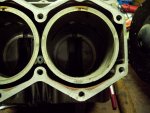OFF THE CLOCK
Cadet
- Joined
- Jun 6, 2015
- Messages
- 21
Hello to all. If owned Ev engines in the past this is my first Johnson. Here is the deal I picked up a engine that had been sitting for awhile I went through the carburetors and changed the waterpump complete new plugs new thermostats kit etc etc. Now i took the boat down to the ramp and Let it idle in the water. The water is coming out of the pisser. But the heads got hot to where I couldn't keep my thumbs on the heads. I checked the temp at the heads ant the Tstat block and everywhere else. (now there was no alarm) but I know this wasn't right temp. I was raised up around these johnson EV engines so I know when there not running correctly. I'm also tooled for major tear down overhaul. And I do have a manual.!So I figured I'd pull the flow hoses off and make sure water was moving around the heads. Started it up there is flow. temp went down (101'ish @ the Heads) Of course. So I took it back home pulled the tstat housing after I bought a kit. When I removed the housing I found a new Purple springs and caps the tstats look good. I replaced them anyway with the kit.Cleaned the housing cleaned the inners pulled the lower unit inspected the lower end with a flashlight. Hooked up a hose to the input tube ran water through it it ran out the heads. Looked inspected looked somemore etc etc. reinstalled back to the ramp/ same issues. Took it back home removed the tstats reinstalled same Issues. Hot at the heads.
I know the older engines would spit water out the 2 holes just below the cowling this one dose not either in the water nor with muffs. Also the 6 holes on top of the cavitation plate. no water coming out there either. I'm at a total loss on where to look other than pulling the block off the base. Any Idea on this? I hope I'm being descriptive enough. I'm no rookie but I don't know everything. Tooled for Major overhaul and had a couple down to the nuts and bolts. Any help would be great. I posed this same questio in another form but this must be for only the skilled to answer. I'm not wanting to bring it in anywhere for the cost would be great chasing a blockage but if I must pull it apart I will do this also. This engine was rebuilt sometime ago and the original owner was an older fella (meaning no dogging it). and it idles like four guys hitting drums not a loose engine would run bang ..bang..bgbg.bg bang this engine is tight with like new compression so I don't want to hurt it by trying to figure it out.. Thanks so much for reading this and in advance thanks for the help..
Signed.
OFF THE CLOCK.
I know the older engines would spit water out the 2 holes just below the cowling this one dose not either in the water nor with muffs. Also the 6 holes on top of the cavitation plate. no water coming out there either. I'm at a total loss on where to look other than pulling the block off the base. Any Idea on this? I hope I'm being descriptive enough. I'm no rookie but I don't know everything. Tooled for Major overhaul and had a couple down to the nuts and bolts. Any help would be great. I posed this same questio in another form but this must be for only the skilled to answer. I'm not wanting to bring it in anywhere for the cost would be great chasing a blockage but if I must pull it apart I will do this also. This engine was rebuilt sometime ago and the original owner was an older fella (meaning no dogging it). and it idles like four guys hitting drums not a loose engine would run bang ..bang..bgbg.bg bang this engine is tight with like new compression so I don't want to hurt it by trying to figure it out.. Thanks so much for reading this and in advance thanks for the help..
Signed.
OFF THE CLOCK.




















